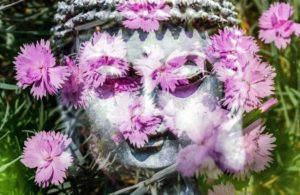As for Moksha and Nirvana, I personally believe that they are the most misunderstood concepts in Buddhism.
Many of you may have read several Buddhist books, but you may not be able to get a clear idea of what Moksha or Nirvana is.
Theravada Buddhism sometimes uses the term ” ash-body-perishing wisdom,” a concept that is close to Nirvana.
This literally means “to perish wisdom by reducing oneself to ashes,” but in this case, “wisdom” seems to refer to “the workings of the mind.
Is Nirvana then to lose body and mind? Is that the state that Theravada Buddhism aims for?
Is such Nirvana really equal to the Theory of Happiness, and is it a sufficient condition to aim for?
If nirvana is to become nothing at all, then why do we live on earth with our individuality, and why are all the irreplaceable memories of our lives wasted…? These questions are only deepening.

And can we simply envy such a “return to nothingness”? Was that the Buddha’s true intention? I am very unconvinced.
Moksha and Nirvana are concepts and conditions that can never be understood without the existence of the Real World (or “the other world” in layman’s terms).
One of the negative legacies of modern Buddhist studies is that the Buddha theory equals the spiritless soul theory.
This has made it impossible to understand moksha and nirvana only from the perspective of the phenomenal world (or more simply put, this world).
However, it has always been difficult to “assume the real world,” and I believe that misunderstandings may have already occurred as far back as the time of the Early Buddhist schools, or even before that.
*Early Buddhist schools : Various schools of Buddhism that were established in the hundred years to several hundred years after the death of the Buddha, when the primitive schools of Buddhism split off.
In this issue, I would like to talk about the theme of “what Moksha and Nirvana are in the first place” as clearly as possible.
First, we will review the standard “view of Moksha and Nirvana” from traditional Buddhist studies, and then, in the latter half of the lecture, we will confirm “what was the Buddha’s true intention in attaining the state of Nirvana from Moksha.
What is the difference between Moksha and Nirvana?
Moksha and Nirvana are quite similar concepts and are often used interchangeably.
Simply stated, the following understanding is sufficient.
- Moksha: a dynamic state in which one breaks through one’s delusion and attains enlightenment.
- Nirvana: the static state of tranquil state that one attains as an effect of Moksha.
Therefore, it can be said that if you understand Nirvana, you also understand Moksha as an effect, so the following explanation will focus on “Nirvana”.
Explore the meaning of Nirvana in its original sense
Nirvana is the Pali word “nibbāna”.
In the Buddhist context, Nirvana means “the state of peace and tranquility where the fires of worldly desires have been extinguished.
In Buddhism, the cause of suffering is extolled as “attachment arising from worldly desires.” Conversely, the logic goes that if worldly desires are eliminated, suffering will cease to exist.
The state in which such suffering has ceased is called ” Nirvana.
Check the meaning of ” Nirvana” from the Four Noble Eightfold Path.
Buddhism is famous for the Noble Eightfold Path. The flow of the Noble Eightfold Path is the “Four Noble Truths.
The Four Noble Truths are specifically the following four.
- The Truth of Suffering (Dukkha)
- The Truth of the Origin of Suffering (Samudāya)
- The Truth of the Cessation of Suffering (Nirodha)
- The Truth of the Path to the Cessation of Suffering (Magga)
Let us briefly review each of these.
- Dukkha : The truth is that life is suffering. It is categorized as the Four Sufferings and Eight Pains
- Samudāya : The truth that suffering is caused by attachment arising from worldly desires.
- Nirodha : The truth is that if we destroy our attachments, we will be liberated and attain a state of tranquil ( Nirvana).
- Magga : Specific methods for perishing attachment, the truth of the Middle Way.
The above definition may be confusing, so let’s paraphrase it as follows
- Dukkha : Life is suffering, isn’t it?
- Samudāya : Suffering has a cause. It is attachment.
- Nirodha : So, if we eliminate our attachments, we will be free from suffering and will be in a state of tranquil peace, right?
- Magga : Noble Eightfold Path is the way to achieve this.
Nirvana,” the subject of this issue, corresponds to the “Nirodha” part of the Four Noble Truths. Nirvana” is the state in which one renounces attachment and attains a tranquil state of being.
In other words, the conclusion or goal of the “Four Noble Eightfold Path” corresponds to ” Nirvana. To put it simply, ” Happiness” is the goal.
Nirvana” as checked by the Three Seals of the Law
Now, let us check ” Nirvana” from the Three or Four Dharma Seals.
A “Dharma Seal” is a sign or banner that says, “This is Buddhism.
In the case of the Three Dharma Seals, it means, “If these three seals are present, it can be said to be Buddhism.
Briefly speaking, the Three Dharma Seals are as follows.
- Impermanence : all things are in transition
- Non-self : all things cannot “exist” by themselves.
- Nirvana : to know the truth of Impermanence and Non-self, to attain Enlightenment, and to attain Happiness.
To these three, the following items can be added to form the Four Dharma Seals.
- Duḥkha: all formed things are sufferings.
Simply put, the state of being covered in worldly desires without knowing the Impermanence and Non-self is “suffering.
This is “all action suffering.
On the other hand, when one understands the truth of the Impermanence and Non-self, one is liberated from attachment and attains Moksha, a state of tranquil tranquility.
This is ” Nirvana.
Thus, from the Three Dharma Seals, it is clear that ” Nirvana” corresponds to the objective part of Buddhism.
A long time ago, it was sometimes said by Western scholars that Buddhism is a pessimistic religion.
However, this is not so. Buddhism is a religion that looks at pessimism in a realistic way while penetrating into optimism.
This may seem a bit of a digression, but in the end, Buddhism can be defined as “a Theory of Happiness based on Ontology and Theory of Time.
- Impermanence : all things are in transition → Theory of Time
- Non-self : all things cannot “exist” by themselves → Ontology
- Nirvana : to know the truth of Impermanence and Non-self, to attain Enlightenment, and to attain Happiness. → Theory of Happiness
You can also check Nirvana from other sources, such as the Twelve Causes, but that’s about it.
What is “nirvana” after all?
Nirvana is a theory of happiness.
But on the other hand, if one knows the truth of Impermanence and Selflessness and renounces attachment, can one really enter Nirvana? We need to think about this a little more.
Nirvana is the “re-sacralization” of life.
…because there is a danger of falling into nihilism if we just accept the truth of impermanence and selflessness as it is.
There is a danger of nihilism, as in, “It’s all going to pass anyway, there’s nothing of substance in this world, it’s empty…”
That is not going to be a positive theory of happiness in the least.
This is why I stated at the beginning of this article that nirvana can never be understood without taking the Real World into account.
By knowing the impermanence and selflessness of this world, the phenomenal world, we need to make the leap of cognition into the real world.
In religious studies terms, this means to re-sacralize life by thoroughly applying pessimism to the present world.
…Is it hard to understand?
The point is that you are just an “avatar” in this world.
Originally you were a resident of the real world, but for the purpose of spiritual evolution, you have come to the phenomenal world in the avatar of a physical body, so to speak, for an internship.
That is the life of this world.
When we live in the real world, we live among people with similar vibrations, so we feel tranquil (nirvana), but on the other hand, there is a disadvantage that there is little stimulation.
There, we are born into the phenomenal world clad in the avatar of the physical body.
Thanks to the existence of the physical body, people of different vibrations can meet each other.
*Reference article. Meaning and Mission of Life
You have to work to eat, so you have to meet people you don’t like.
You go to school to prepare to work, so you will meet people of different vibrations there as well.
On the other hand, sometimes you have to leave someone you love.
In Buddhist terminology, this is called the suffering of hatred and separation from love.
The suffering of old age, sickness, and death is also peculiar to the phenomenal world.
Despite these sufferings, in the phenomenal world, we can meet wonderful people whom we cannot meet in the real world, or people whose interests are different from our own.
This is where you can have the opportunity to improve your soul and build your soul’s breadth.
That is the meaning of being born all the way into the phenomenal world.
That is, it is a temporary world. It is just like a business trip or a training course at work.
When we are convinced that we are eternal beings and realize that the real world is our home, we see the phenomenal world in a completely different light.
We awaken to the mission of spiritual evolution and the transformation of the phenomenal world into a Buddhist land.
The true “Nirvana” is to be able to view the phenomenal world from the viewpoint of the real world and to make the most of it.
Because it is a temporary world, we can be in a tranquil state of mind.
When you are playing RPG games, you may be happy or sad, but you also have a bird’s eye view of the game, don’t you?
It is the same thing.
You are training your soul while playing RPG games with an avatar called the body.

Life in this world is a process of shedding one’s self, and in the process, revealing one’s more essential self.
Therefore, the true Nirvana is a state of mind in which one can make full use of the phenomenal world from the perspective of “eternal certainty” and “the real world is one’s home.
Nirvana is not in fixed or static, but in dynamics.
I would like to delve a little deeper into the meaning of “the real world is the standing point.”
The real world (the other world) is structured in various levels, depending on the state of mind of each person.
Even within the same “level,” there are also different types of habitations depending on one’s interests, and when classified in detail, it can be said that the world is infinite.
Then, depending on where in the real world you are from, your standpoint will naturally be different.
“I managed to be born from the heavenly realm just in time!” or “I was born from the Bodhisattva realm! There are many different patterns.
If Nirvana is to “live to the fullest in the phenomenal world while keeping the real world as one’s standpoint,” then since we all have different points of standpoint, it follows that “there are differences in ability to achieve Nirvana,” right?
Nirvana tends to be thought of in terms of the dualism of “in Nirvana” and “not in Nirvana. And that is not an incorrect answer.
For if one does not have “the real world as a standpoint,” one cannot say that one has attained Nirvana.
On the other hand, there are stages in the state of nirvana, which, in a nutshell, can be said to be in the following order.
Minimum nirvana -> Nirvana of excellent souls -> Nirvana of saints -> Nirvana of greats -> Nirvana of Buddha and Savior class.
Thus, the fact is that “there are stages of Nirvana”.
And “a little more advanced Nirvana through the refinement of the soul!” and so on, Nirvana is not fixed and static, but can be fluid and dynamic.
In summary, we can say that Nirvana is in the dynamism.
Incidentally, the same is true of ” Enlightenment”.
We tend to think in dualistic terms [enlightened – unenlightened].
But it isn’t, and depending on the degree to which you are enlightened, you can say, “There are infinite analog ladders of enlightenment.
Moksha and Nirvana will move us from “deluded reincarnation” to “proactive reincarnation”.
Traditionally in Buddhism, enlightenment has been considered to be liberation from reincarnation.
But this is a misunderstanding of the Buddha’s true intentions. It is a misunderstanding of the process of oral transmission.
The word “reincarnation” is a translation of the Sanskrit word “samsara,” which means “to flow.
Samsara has been used since ancient times to mean “world,” and it is said that it is incorrect to interpret all samsara as “rebirth.
So, in Buddhism, samsara is used to mean “the world of delusion.
This shore” as opposed to the other shore (nirvana), in short, samsara is the state of being ruled by worldly desires.
Thus, the Buddha was preaching “to break through the life of delusion and move on to the life of wisdom” by means of the Buddha Dharma.
Let’s lay this out further.
If we think of enlightenment and Nirvana as described above, we should be able to proactively make full use of the mechanism of reincarnation, which is the back and forth between the real world (the other world) and the phenomenal world (this world).
Then we can see that Moksha is to move away from passive reincarnation caused by delusion to proactive reincarnation with the real world as one’s standpoint.
And such a state of being is called Nirvana.
This is the correct answer. This is what the Buddha originally preached.
This is why the Buddhist scriptures often say, “The life of delusion has been exhausted.
Nirvana is a Buddhist land theory (utopianism)
Now, let us consider ” Nirvana” in more depth.
The three Dharma seals were the following three
- Impermanence
- Non-self
- Nirvana
A deeper analysis of these three Dharma marks, among which are the Impermanence and the Non-self reveals the following.
- Impermanence : All things pass. -> Time Theory
- Non-self : The various existences cannot exist by themselves -> 0ntology
And if we understand that the Impermanence is a theory of time, then what we can see from this is that we can derive Wisdom from Impermanence.
When we look back over the passage of time, we can see the connection between cause and effect. From this, we can derive Wisdom.
On the other hand, Non-self is an ontology.
The fact that “being cannot exist by itself” means that “people (beings) live by supporting each other.
Therefore, we can derive Compassion from the Dharma selflessness.
*Reference article. Law of Dependent Origination(Causation / Pratītyasamutpāda) – Thinking of Dharma in “Being and Time”
Let’s sort it out.
- Impermanence: Time Theory -> wisdom
- Non-self: Ontology -> Compassion
What, then, is it that is shaped by Wisdom and Compassion?
It should not end with mere personal peace of mind.
Because ” Compassion” is compassion, it desires to be infinitely pervasive among beings.
Isn’t the state of Compassion spreading with Wisdom the very ” Buddhist land”?
Hence, here, ” Nirvana” comes down to the Buddhist land theory (or, in Western terms, Utopianism).
Let’s summarize.
- Impermanence : Wisdom
- Non-self : Compassion
- Nirvana : Buddhist land

The conclusion is as follows “The Buddha’s true intention was to preach a theory of the Buddhist land in which Wisdom and Compassion are the two wheels of the wheel. That is the true “Nirvana.
Conclusion.
“The Buddha’s true intention was to preach the theory of the Buddhist land, which is based on both wisdom and compassion. That is true Nirvana.”







Comments